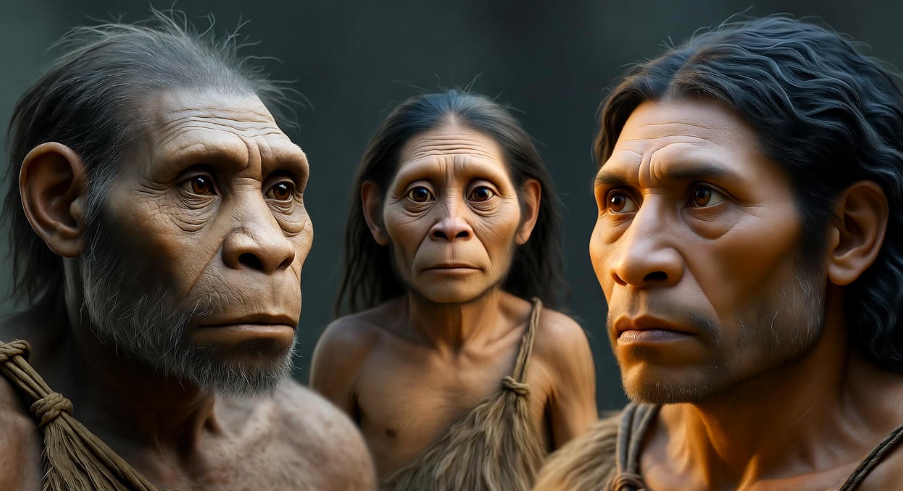Have you ever thought about how many kinds of humans once walked the Earth before us? 🌍
Most of us know about Homo sapiens — that’s us — but what many people don’t realize is that we had many “cousins.” These were ancient human species that lived thousands (and sometimes millions) of years ago. Some of them were quite similar to us, while others looked and lived in completely different ways.
Let’s take a trip back in time and explore these long-forgotten members of our family tree — the ones you probably never knew even existed.
The Hidden Family Tree of Humans 🧬
Before diving into the names, it helps to understand one simple thing: we weren’t alone. Humans evolved over millions of years, and during that time, several different species of humans existed — sometimes even at the same time!
Scientists often use fossils, bones, and tools to learn about them. You can imagine how exciting it must be to find a piece of a jawbone or skull that’s thousands of years old — and realize it belonged to a different kind of human.
Here’s a quick table that shows how different ancient human species compare:
| Species Name | Time Period (Approx.) | Key Region | Main Traits |
|---|---|---|---|
| Homo habilis | 2.4–1.4 million years ago | Africa | Used stone tools, smaller brain |
| Homo erectus | 1.9 million–110,000 years ago | Africa, Asia | Walked fully upright, used fire |
| Homo naledi | 250,000 years ago | South Africa | Small brain, ritual behavior |
| Homo floresiensis | 100,000–60,000 years ago | Indonesia | Tiny height (~3.5 ft), “hobbit” nickname |
| Denisovans | 300,000–50,000 years ago | Asia | Interbred with humans |
| Homo luzonensis | 67,000 years ago | Philippines | Small, primitive features |
| Neanderthals | 400,000–40,000 years ago | Europe, Asia | Strong build, used tools, buried dead |
These are just a few of our ancient relatives. Let’s explore each one — in simple and human language — to see who they really were.
Homo habilis – The Handy Human 🪨
If you could go back about 2 million years, you’d meet Homo habilis. The name literally means “handy man,” because these were the first humans who started making simple stone tools.
They weren’t tall — maybe around 4 feet — and their brains were smaller than ours, but they were clever enough to shape stones for cutting and smashing food. Imagine early humans sitting together, cracking nuts or carving meat — that was Homo habilis’ world.
It’s believed that Homo habilis was the link between older ape-like ancestors and more modern humans. They had shorter arms, longer legs, and spent more time walking upright.
Homo erectus – The Fire Keeper 🔥
Next comes Homo erectus, one of the most successful ancient species ever to exist. They appeared around 1.9 million years ago and lived for nearly 1.5 million years — a huge stretch of time!
These humans were the first to walk fully upright like we do. They were taller, stronger, and much smarter than Homo habilis. Most importantly, they learned to use fire — a massive turning point in human evolution.
Fire gave warmth, light, and protection. It also made food easier to eat. You could say Homo erectus lit the first spark that changed everything.
They even started moving out of Africa into Asia — becoming the first humans to travel across continents. 🌍
Homo naledi – The Mysterious Cave Dwellers 🕳️
Discovered only recently (in 2013) in South Africa, Homo naledi surprised scientists. They had small brains — about the size of an orange — yet showed signs of advanced behavior.
Fossils were found deep inside a cave system called the “Rising Star.” It seemed as if these ancient humans had carefully placed their dead there — something no other primitive species was thought to do.
How could small-brained creatures do something so symbolic and emotional? That’s what made Homo naledi so mysterious. They changed how scientists thought about intelligence and human behavior.
Homo floresiensis – The Real-Life Hobbits 🧝♀️
Meet Homo floresiensis, often called “the hobbit humans.” Why? Because they were tiny — just about 3.5 feet tall!
These humans lived on an Indonesian island called Flores about 100,000 to 60,000 years ago. Despite their small size, they made tools, hunted animals, and lived in communities.
Their small brains didn’t stop them from being clever. Scientists think isolation on the island made them evolve into smaller bodies — a common pattern in evolution known as “island dwarfism.”
When their bones were first discovered, people thought it was a modern human child. But tests proved otherwise — they were a completely different species!
Denisovans – The Hidden Cousins of Asia 🧑🔬
Unlike others, Denisovans weren’t discovered through full skeletons. Instead, scientists found only a finger bone and a few teeth in a Siberian cave in 2008.
Yet from that tiny bone, DNA studies revealed an entirely new species — one that lived in Asia around 300,000 to 50,000 years ago.
Here’s something mind-blowing: their genes still live in us today! Many people in Asia and Oceania have Denisovan DNA — proof that Homo sapiens and Denisovans interbred at some point. 🧬
They likely adapted to cold weather, which is why their descendants might have helped modern humans survive in harsh mountain regions like Tibet.
Homo luzonensis – The Tiny Islanders of the Philippines 🇵🇭
In 2019, another surprise came from the Philippines. Scientists found fossils of a small, unknown species on the island of Luzon — they called them Homo luzonensis.
These humans stood less than 4 feet tall and had a strange mix of ancient and modern traits. For example, their fingers and toes were curved, suggesting they still climbed trees, yet they also walked upright.
They lived about 67,000 years ago — meaning they shared the planet with Homo sapiens, Neanderthals, and Denisovans. Imagine that — four different human species existing at the same time!
Neanderthals – The Strong and Smart Relatives 💪
Neanderthals are probably the most famous of our ancient cousins. They lived in Europe and Asia around 400,000 to 40,000 years ago.
Forget the old cartoon image of “cavemen” — Neanderthals were actually very intelligent. They made tools, wore clothes, painted caves, and even buried their dead with care.
They were also physically stronger and had larger skulls than us. But as modern humans spread across Europe, Neanderthals slowly disappeared — likely through a mix of interbreeding and competition.
And yes, you probably have a bit of Neanderthal DNA too! Studies show that almost all non-African humans today carry around 1–2% of Neanderthal genes.
Why So Many Species Disappeared ❌
It’s sad but fascinating — most ancient humans went extinct. Some died out because of changing climates, others because they couldn’t compete with Homo sapiens.
Our ancestors were adaptable. They learned faster, built better tools, communicated through language, and formed bigger social groups. That gave them a huge advantage.
But that doesn’t mean our cousins were failures — they laid the foundation for who we are today. Every extinct species added a new piece to the puzzle of humanity.

How Scientists Discover New Human Species 🔍
Finding new species is like detective work. It takes years of searching, digging, and analyzing. Here’s how it usually happens:
| Step | Process | Example |
|---|---|---|
| 1 | Fossil discovery | A small bone or tooth found in a cave |
| 2 | Dating | Scientists use carbon or uranium dating to check age |
| 3 | DNA testing | Helps identify if it’s a new species |
| 4 | Comparative study | Compare fossils with known species |
| 5 | Naming & publication | Officially naming the new human species |
It’s a slow process, but each discovery reshapes our understanding of evolution. Who knows — maybe more unknown humans are still waiting to be found!
Interesting Facts About Ancient Humans 🧠
-
Some ancient humans like Homo erectus used fire 1 million years ago.
-
Neanderthals had larger brains than modern humans on average.
-
Denisovan DNA helped Tibetans survive at high altitudes.
-
Homo floresiensis shared islands with giant rats and tiny elephants.
-
Several species might have met and interacted — not all were enemies.
What These Discoveries Teach Us ❤️
All these ancient humans — big and small, smart or simple — tell one big story: humanity didn’t happen overnight. It evolved step by step, species by species.
We didn’t come from a single line of evolution; instead, it was like a tangled tree, full of branches, experiments, and surprises.
Each ancient human species added something to what we are today — intelligence, adaptability, creativity, emotion, or courage.
It’s beautiful to think that deep in our DNA, we carry a little bit of all of them. 🌱
FAQs about Ancient Human Species
Q1: Did all these human species exist at the same time?
Yes, several species overlapped. For example, Homo sapiens, Neanderthals, Denisovans, and Homo floresiensis lived during the same period.
Q2: Why did only Homo sapiens survive?
We had stronger social connections, advanced communication, and better adaptability to climate changes.
Q3: Can we still find new human species?
Absolutely! Scientists believe more are yet to be discovered, especially in unexplored caves and islands.
Q4: Did humans ever meet Neanderthals or Denisovans?
Yes, and even interbred with them. That’s why their DNA still exists in us today.
Q5: Which species was the most intelligent?
Probably Homo sapiens and Neanderthals. Both showed creativity, symbolic thinking, and complex behavior.
Final Thoughts 🌍
When we think of ancient humans, it’s easy to imagine a single path — from apes to us. But the truth is far richer and more exciting. There were many versions of “human” before us, each trying to survive in its own way.
They hunted, built tools, cared for their families, and even dreamed — just like we do. Their stories remind us that evolution isn’t just about survival; it’s about connection, discovery, and growth.
So next time you look in the mirror, remember — you’re not just you. You’re the result of millions of years of change, shaped by countless human hands before yours. ✨

Leave a Reply